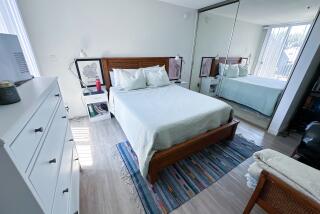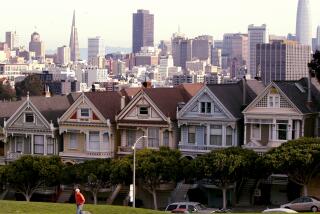Green-building features are going mainstream
- Share via
Once considered eccentric and dowdy, not to mention expensive, green-home building’s looks have gotten a makeover as it creeps closer to mainstream housing.
Sure, with the real estate slump still taking a toll on building of all kinds of homes, there’s not a lot of it out there. But green is no longer the plain Jane of home building. Plus, environmentally friendly building techniques are showing up more frequently in multifamily and subsidized dwellings, not just custom homes, said Rick Schwolsky, editor in chief of EcoHome magazine, which focuses on green-building products and practices.
Schwolsky’s publication recently bestowed accolades on a broad array of homes — from extraordinary custom residences to market-rate condo complexes — that its panel of judges deemed exceptional for their environmental-mindedness and aesthetics. He talked about the directions green is taking, based on the results of the annual EcoHome Design Awards:
How does a home qualify as green for your contest?
We require third-party certification as an eligibility criterion. So to enter our competition it would already have to have met the green-building certification requirements from an organization such as the U.S. Green Building Council, the Energy Star program or any number of national, state and regional certification programs.
The performance aspects of the home have been measured by one standard or another, which frees us to focus on the integration of architecture and performance. That’s our focus in the contest, to see how well the designers and architects integrated the features into a home. We had about 120 entries this year.
What stood out?
The custom homes this year were beautiful. I used to be a custom builder, so of course I’m attracted to them. Custom homes are always going to be the race cars of residential construction. Our industry needs them as a testing ground for technology and design elements, to prove themselves out.
But the heartening thing is seeing how in multifamily and affordable housing, people in those markets are increasing their adoption of green principles.
It’s always been said that consumers are usually only willing to “green” their homes to save on energy costs — that sustainable building practices and other concerns take a back seat to lowering the heating and cooling bills. Is that still the case?
Energy will always — in my lifetime, anyway — be the first focus because the industry is still stuck talking about payback, return on investment. And energy savings is the only measurable place where you can do that. Plus, you’re starting to see builders who are guaranteeing annual utility bills — that resonates with buyers.
But second to that — and this is growing, judging from the entries in this year’s contest — is the health aspect of green building. People are starting to get it, to understand that a green home, or a sustainable home, will be a healthier place. Building designers are starting to be more aware that the tighter a house is, the more important the indoor air quality is. Toxins and dust and mold and potentially harmful emissions accumulate more in a tighter home. The big trend in the industry is toward heating, ventilation and air-conditioning systems that bring fresh air into the home and filter it in an energy-efficient manner.
Third would be the use of sustainable building materials. That’s seen not only in products where you get recycled content, but a lot of manufacturers are doing life-cycle assessments of their products, to evaluate the environmental impact of a product through all the stages of its life — manufacturing and delivering it, disposing of it, etc.
How is the industry doing in terms of making green less expensive?
From what I see in the industry, the cost is coming way down.
Production [or tract] builders are putting down some really good products within their price points. Some of them are working with supply chains and vendors, looking for zero-cost-increase options for some features that would have been more expensive upgrades.
There are different forces driving this. In some places, building codes are going to drive green homes into better [price] territory. If you want to build in California, for instance, there’s a minimum threshold of performance.
Umberger writes for the Chicago Tribune.
More to Read
Inside the business of entertainment
The Wide Shot brings you news, analysis and insights on everything from streaming wars to production — and what it all means for the future.
You may occasionally receive promotional content from the Los Angeles Times.










